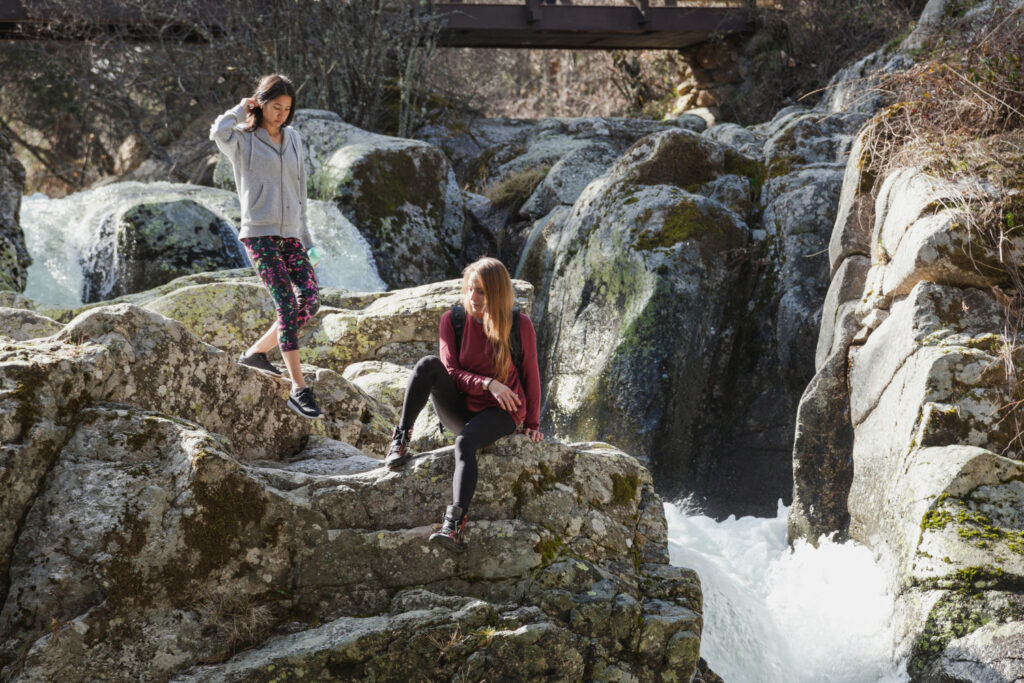Burney Falls, often hailed as the “Eighth Wonder of the World” by those who’ve witnessed its beauty, is a sight to behold and a journey to be experienced.
Located within McArthur-Burney Falls Memorial State Park, this natural wonder draws visitors from around the globe.
Burney Falls has a towering 129-foot waterfall, which flows at an astonishing rate of 100 million gallons daily. The falls present a mesmerizing spectacle that gets everyone’s attention.
The source of this incredible volume is not solely the river above but a vast underground spring that feeds the falls, ensuring its flow remains constant throughout the year, regardless of the season.
If you’re soon going to Burney Falls, save Global Newsly’s guide on how long is the hike to Burney Falls, where we will cover everything, from the length and details of the hike to the best seasons for your visit, camping options, and everything in between.
Exploring Burney Falls
The falls cascade over a basalt cliff, surrounded by a lush forest. The water is crystal clear and icy blue. It plunges into a pool below, creating a mist that refreshes and invigorates everyone below the fall.
This waterfall, fed by the river and an extensive underground spring system, ensures a spectacular display year-round, making it a perennial attraction for its visitors.

Geological history of Burney Falls
The geological history of Burney Falls is as fascinating as its beauty.
Burney Falls is a remarkable natural wonder with a rich geological history that spans millions of years.
The falls themselves are fed by Burney Creek, originating from the park’s underground springs, and dramatically plunge 129 feet over basalt cliffs.
The area’s geological story is a fascinating journey through time, shaped by volcanic activity, glacial movements, and the relentless forces of water and erosion.
The geological foundation of Burney Falls and its surroundings is closely linked to the Cascade Range, which is part of the Pacific Ring of Fire, a zone known for its intense seismic and volcanic activity.
During the Pleistocene epoch, the region’s landscape began to take its current form millions of years ago, when volcanic eruptions were frequent. The basalt over which Burney Falls flows is a product of this volcanic activity, forming a hard, erosion-resistant layer that has withstood the test of time.

During the last Ice Age, glaciers carved through the landscape, shaping valleys and leaving behind a terrain rich in features.
As the climate warmed and the glaciers retreated, meltwater and streams began to erode the softer volcanic rocks beneath the basalt layer, creating the cavernous spaces and tunnels through which the waters of Burney Creek now flow before cascading over the falls.
This undercutting and differential erosion gives Burney Falls its distinctive appearance, with multiple streams of water spouting from the rock face, creating a veil-like effect.
The large amounts of groundwater in the area, which feed the falls year-round, is another exciting aspect of Burney Falls’ geological history.
These underground springs are part of a vast aquifer system that collects water from rainfall and snowmelt, filtering it through porous volcanic rocks before it emerges at the falls.
This natural filtration process ensures that the water is incredibly clear and maintains a constant flow, even during periods of drought.
How Long is the Hike to Burney Falls?
The journey to Burney Falls is accessible via a well-maintained trail that offers both beauty and a moderate challenge, suitable for hikers of all levels.
The main trail to the falls is a loop that spans approximately 1.3 miles, allowing visitors to experience the falls from various vantage points. With a gentle descent towards the base of the falls, hikers can feel the spray of the water and enjoy the cool, misty air.
The trail is clearly marked and features informational signs that provide insights into the local ecology and geology.

For those seeking more adventure, several connecting trails offer extended hikes through the park’s 910 acres of wilderness. These trails vary in difficulty and length, providing options for a quick scenic loop or a more strenuous exploration of the area’s natural beauty.
Regardless of the path chosen, visitors are advised to wear appropriate footwear, carry water, and prepare for the weather conditions, ensuring a safe and enjoyable experience.
The hike to Burney Falls is an opportunity to connect with nature, to pause and reflect amidst the beauty of the cascading water and verdant forest.
Best Season to Visit Burney Falls
Burney Falls is a year-round destination for visitors. But each season has its down” falls” and advantages.
Spring
The falls are at their most potent in the spring, fed by the melting snow from the surrounding mountains.
This season brings the area to life, with wildflowers blooming along the trails and the vibrant greens of new foliage. The cool, crisp air and the thunderous sound of the falls create an invigorating atmosphere for visitors.

Summer
The weather in Summer is perfect for exploring the trails, picnicking in the park, and enjoying the natural swimming areas below the falls.
The summer months also offer the longest days, giving visitors ample time to soak in the beauty of the falls and explore the surrounding area.
While this season is the most popular and can be crowded, the fall’s refreshing mist provides a welcome respite from the heat.
Autumn
Autumn brings a serene beauty to Burney Falls, with the changing leaves painting the landscape in gold, orange, and red hues.
The cooler temperatures and fewer visitors make it an ideal time for those seeking a more peaceful experience.
The fall season also offers a different perspective on the falls, as the water flow is gentler, allowing for more precise views of the underlying rock formations and the vibrant autumn colors reflected in the pool below.
Winter
Winter transforms Burney Falls into a quiet, snowy wonderland.
The falls continue to flow, often surrounded by ice and snow, creating a stunning contrast against the stark winter landscape.
This season is perfect for those who enjoy the solitude and beauty of nature in its most tranquil state.
While access to some trails may be limited due to snow, the main view of the falls remains accessible, offering a magical winter scene.
Why You Should Visit Burney Falls in Spring
While each season offers its own unique experience, visiting Burney Falls in the spring provides a particularly spectacular display.
The increased water flow from the snowmelt enhances the falls’ majesty, making the cascade even more impressive.
The surrounding landscape is alive with the fresh bloom of wildflowers and the vibrant greens of new leaves, adding to the overall beauty of the hike.
Spring also strikes a balance between the cooler winter months and the busy summer season, offering a quieter visit than during peak tourist times while still enjoying comfortable weather.

Camping Near Burney Falls
For those looking to extend their stay near Burney Falls, the surrounding area offers a variety of camping options that cater to different preferences, from rustic back-to-nature experiences to more comfortable accommodations with additional amenities.
Within McArthur-Burney Falls Memorial State Park, visitors can find well-maintained campgrounds that provide direct access to the park’s natural wonders, including the falls.
These campgrounds are equipped with sites for tents, RVs, and even cabins for those who prefer a more solid structure over canvas. Each area typically includes a fire ring, picnic table, and access to shared facilities such as restrooms and showers, ensuring a comfortable and convenient camping experience.

Recommended Campsites Near Burney Falls
- Burney Falls Campground
One of the most popular campgrounds is the Burney Falls Campground, located within the state park.
This campground offers a mix of sites for tents and RVs, with easy access to the park’s trails, including the short hike to Burney Falls.
The proximity to the falls allows campers to enjoy the sights and sounds of the cascading water at their leisure, making it a prime spot for those who wish to fully immerse themselves in the area’s natural beauty.
- Lake Britton Campground
Another highly recommended option is the Lake Britton Campground, a short drive from Burney Falls.
This campground is ideal for visitors interested in water activities, as it offers access to Lake Britton’s swimming, fishing, and boating opportunities.
The sites here provide a peaceful setting among the pine and fir trees, with amenities that ensure a comfortable stay while allowing guests to feel connected to the natural environment.
For adventurers looking to explore the wilderness, the Pacific Crest Trail (PCT), which is a 45-minute drive from Burnley Falls, offers several backcountry camping opportunities in the vicinity.
While these sites are more rudimentary and require hikers to be self-sufficient, they offer unparalleled access to the serene beauty of the Cascade Range and a true sense of solitude.





Thanks for the accommandation recommendations, I was searching for some close by places to stay at during my visit.
Comments are closed.